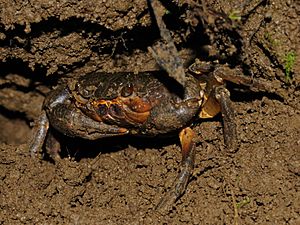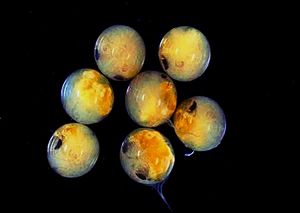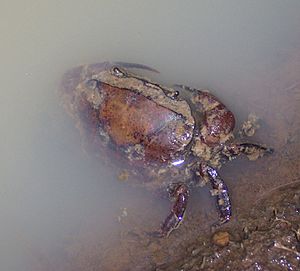Freshwater crab facts for kids
Freshwater crabs are special crabs that live in fresh water, like rivers, lakes, and streams. Most of them are found in warm, tropical, and subtropical parts of the world.
Scientists have found about 1,300 different kinds, or species, of freshwater crabs. There are many more types of crabs in the world, around 6,700 in total! Experts believe there might be even more freshwater crab species that we haven't discovered yet, possibly up to 2,155!
Freshwater crabs act differently from ocean crabs. Most crabs release many tiny babies, called larvae, into the water. These larvae then have to survive on their own. But freshwater crabs are different; they actually take care of their young.
Many freshwater crabs live only in very small areas. This is called being endemic. If something threatens their home, like pollution or habitat loss, these crabs can quickly become threatened with extinction.
How Freshwater Crabs Grow and Live
Freshwater crabs have a unique way of growing up. Unlike many other crabs, their eggs hatch directly into tiny juvenile crabs. This means they skip the free-swimming larval stages that most marine crabs have. All the early baby stages happen inside the egg.
These crabs lay fewer eggs than ocean crabs, usually only a few hundred. But their eggs are quite big, about 1 millimeter wide. This is much larger than the tiny eggs laid by marine crabs, which can number in the hundreds of thousands!
Living in fresh water means crabs need to control their body's water and salt levels. Freshwater crabs are amazing at this! They can take salt back from their urine so they don't lose too much. They also have special ways to keep water inside their bodies.
Besides their gills, freshwater crabs have a special "pseudo-lung" inside their gill area. This allows them to breathe air when they are out of the water. These special features help them live on land for some time. However, they still need to go back to water regularly to get rid of waste like ammonia.
Where Freshwater Crabs Live and Why They Need Our Help
You can find freshwater crabs all over the tropical and subtropical parts of the world. They live in many different watery places. Some prefer fast-moving rivers, while others live in swamps. You might even find them in tree trunks or deep inside caves!
Most freshwater crabs are nocturnal, meaning they come out to find food at night. Many of them are omnivores, eating both plants and small animals. But some are picky eaters! For example, the Platythelphusa armata crab from Lake Tanganyika mostly eats snails.
These crabs are an important food source for many other animals, including different vertebrates.
In some areas, like West Africa, crabs living in open grasslands (savannas) tend to be found over larger areas. But crabs living in thick rainforests often stay in smaller, more specific places. In East Africa, mountain crabs have very limited homes, while crabs from the lowlands are found more widely.
Sadly, many freshwater crabs are in danger. For the species we have enough information about, about 32% are threatened with extinction. For example, in Sri Lanka, 49 out of 50 freshwater crab species are found only there. More than half of these unique Sri Lankan crabs are considered critically endangered, meaning they are at very high risk of disappearing forever.
See also
 In Spanish: Cangrejo de agua dulce para niños
In Spanish: Cangrejo de agua dulce para niños




